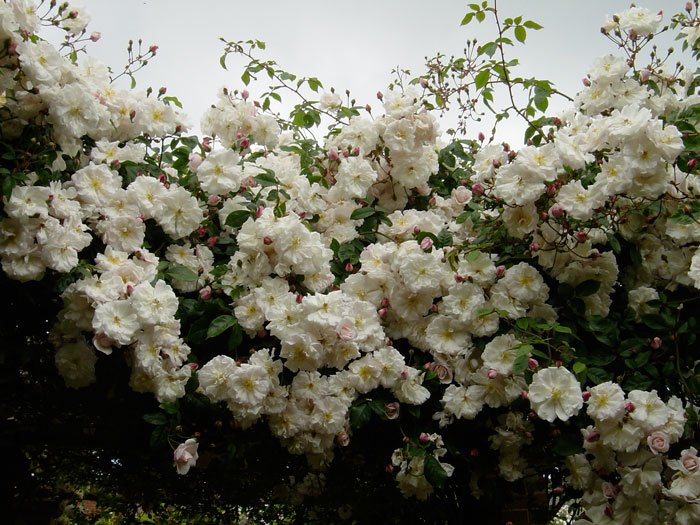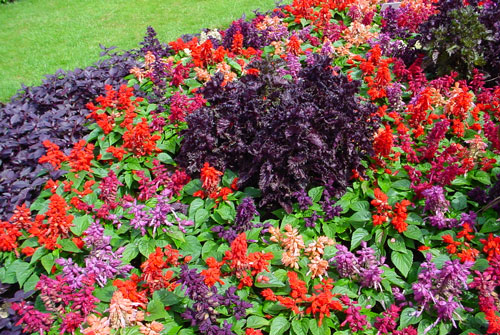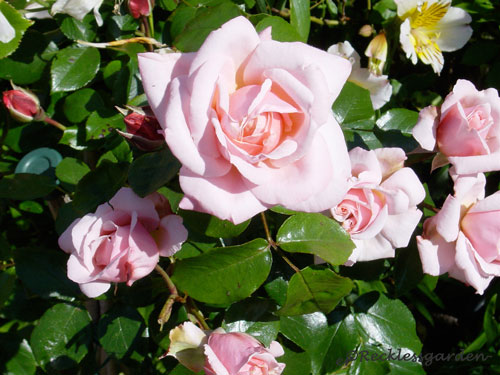July Garden Diary
This month, Geoff Hodge looks at jobs in the garden in July. He takes a look at reducing your garden’s reliance on water and the importance of deadheading and feeding. This column is brought to you by The Scotts Miracle-Gro Co.
During the height of summer, your garden should now be looking absolutely fabulous. So make the most of it with family weekends, barbecues and al fresco dining. However, you can’t rest on your laurels! There are still jobs that need doing to keep it looking great all through summer. Watering will be the main job for most of the month – as long as we have periods of hot, sunny weather – and can take up a lot of precious garden enjoyment time. So do whatever you can to reduce your garden’s reliance on water.
FLOWER BEDS & BORDERS
Having already spent a lot of time, effort – and probably money – on your bedding plant displays, it pays to ensure they flower their heads off for as long as possible – well into autumn, depending on the weather.
Make sure the plants are well watered during prolonged dry periods, to prevent the soil drying out. A good soaking once a week is better than a little and often approach, which can encourage surface rooting, making the plants more susceptible to dry weather. Regular feeding with a liquid plant food gives them the energy they need to flower on and on. One easy way to feed and water your plants at the same time is to use a hose-end feeder. This will save you time each week and help remind you to feed regularly.
Deadheading plants as the flowers fade prevents the plants wasting their energy on producing seeds. This involves removing both the faded flower and the seed head or seedpod developing behind the flower. As a result, they will then continue to flower profusely for as long as possible.
Many herbaceous and perennial plants will have produced their first flush of summer flowers and will need some attention to tidy them up and even encourage some to flower again. Cut back flower stems down to their base with secateurs or, for plants like hardy geraniums, remove the faded flowers and old foliage with shears. Feed well afterwards with a high potash liquid feed to ensure further flushes of flowers.
Topical tip
Inspect lilies for lily beetles whose larvae can strip a plant of leaves and flower buds in a matter of days. If any are present, either physically remove them or spray plants with a systemic insecticide.
PATIO GARDENING
Frequent, regular watering is essential for plants growing in tubs, containers and especially hanging baskets, which are very prone to drying out. This could mean every day during warm, sunny or windy weather. The aim should be to keep the compost evenly moist, without cycles of drying out followed by waterlogging. If you forget to water regularly, you’re away from home for most of the day or when you go away for weekends or holidays, watering becomes more of a problem. Installing a drip watering system and a battery-operated water timer removes all the stress, as it does the watering for you! Regular feeding and deadheading, as recommended under Flower Beds & Borders, is also vital for a spectacle of colour throughout the summer and into autumn.
Topical tip
If your patio needs some more colour – maybe you’re having friends and family around for a party or BBQ – and needs a bit of sprucing up, pop along to your local garden centre. They will have lots of large plants in flower to provide instant impact.
LAWNS
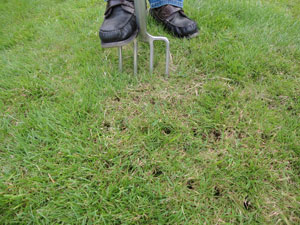 If your lawn isn’t looking its best right now, then it may be in need of some care and attention to get it looking green and lush. Correct mowing and good feeding are summer lawn essentials, as is controlling any weeds and repairing bare and worn out areas. Liquid feeds are a better choice compared to granular feeds during dry weather. They will get to work and start greening up the lawn in a matter of days. Weeds can be controlled with a liquid feed and weed, or a liquid lawn weedkiller. Bare patches and thin areas can be repaired with new grass seed or, better still, a lawn repair kit. Just remember to keep the grass seed well watered while it’s establishing.
If your lawn isn’t looking its best right now, then it may be in need of some care and attention to get it looking green and lush. Correct mowing and good feeding are summer lawn essentials, as is controlling any weeds and repairing bare and worn out areas. Liquid feeds are a better choice compared to granular feeds during dry weather. They will get to work and start greening up the lawn in a matter of days. Weeds can be controlled with a liquid feed and weed, or a liquid lawn weedkiller. Bare patches and thin areas can be repaired with new grass seed or, better still, a lawn repair kit. Just remember to keep the grass seed well watered while it’s establishing.
During an average British summer, regular rain showers should keep the lawn adequately watered and prevent it turning yellow. But if not and prolonged dry periods are likely, it is definitely worth getting out the sprinkler to give the grass a thorough soaking.
If the soil is already dry, and to ensure the water soaks in instead of running off, spike the surface with a garden fork first. To measure how much water is needed and being applied, place one or two jam jars under the water. When there is 2.5cm (1in) of water in the jam jar, the lawn has received enough water. Time how long this takes and you’ll know when it’s time to turn off the sprinkler or move it to another part of the lawn.
Topical tip
Use edging shears to regularly trim around the edges of the lawn to create a sharp outline. This contrast between the edge of the lawn and the surrounding beds and borders gives a great look and prevents grass growing into the borders.
GROW YOUR OWN
Vegetables
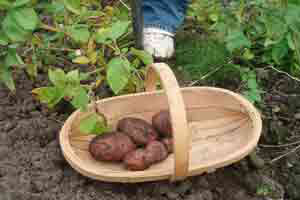 There’s still time to make successional sowings of salad and quick-maturing crops to ensure a regular supply through the rest of the summer and into autumn.
There’s still time to make successional sowings of salad and quick-maturing crops to ensure a regular supply through the rest of the summer and into autumn.
To ensure bumper crops, make sure the soil is kept evenly moist and doesn’t dry out. If it does, it will lead to poor yields, bitter flavours and root crops cracking and splitting. Pay particular attention to peas and beans and all fruiting crops, otherwise they’ll stop producing, and harvest them regularly as soon as they’re ready.
Most vegetables will also benefit, and produce better and bigger crops, when fed weekly with a liquid plant food. To ensure large crops and great flavour from tomatoes, peppers, aubergines and other fruiting vegetables, feed every fortnight with a high potash liquid plant food.
Keep earthing up potatoes to improve the yield and prevent the ones growing near the surface turning green. They will need watering if the weather is dry, as this will help to swell the developing tubers and so improve the yield.
Topical tip
Watch out for greenfly, blackfly, whitefly and caterpillars on vegetables. If you see these pests, spray them with a suitable recommended insecticide.
Fruit
Keep all fruit, but especially wall-trained and stone fruit, well watered during fruit set and fruit development to ensure they carry a good crop. Mulching fruit with a 7.5-10cm (3-4in) thick layer of organic matter will help retain moisture around the roots as well as keeping weeds away. You can begin summer pruning of restricted forms of apples and pears, such as cordons, espaliers and pyramids. In cold and northern regions, delay this until August. Cherries and plums can be summer pruned to remove excess growth after cropping. Thin apples after the June drop if the fruit is still overcrowded. Remove blemished and king (that is central) fruits from the clusters first.
Cut back sideshoots on gooseberries to four or five leaves, or just beyond the fruit clusters. This will speed ripening by increasing sun on the fruit, encourage fruit bud formation for next year, and control aphids on the new growth. Red and white currants can be pruned in the same way.
When summer-fruiting raspberries have finished cropping, cut down the old fruiting canes to ground level. As new growth is produced tie it in to the supports. Don’t prune autumn-flowering raspberries; this is done in late winter.
Continue to tie in and train new blackberry shoots. Keep new shoots separate from older, fruiting ones to make pruning later in the year easier.
Topical tip
Protect strawberries, raspberries, redcurrants and other fruit from birds by covering plants with suitable netting.
TREES, SHRUBS, ROSES & CLIMBERS
Roses are very hungry plants and will need a second feeding now to ensure they continue flowering all summer – and beyond. Apply a granular rose feed and water in well. Roses also need deadheading to keep them flowering profusely. The old advice was to cut back the flowering stems by around 10-15cm (4-6in). This is no longer recommended, and it is far better to simply and carefully snap off the faded flower and seedpod with thumb and forefinger.
In hot, dry weather, roses and many other flowering plants are prone to powdery mildew disease. If you see the first signs of this disease, spray the foliage thoroughly with a systemic fungicide. If pests are also present, then a combined pesticide and fungicide can be used.
Flowering shrubs that blossom in early summer such as weigela, philadelphus and jasmine will benefit if you cut back the flowered shoots to strong new growth immediately after all the flowers have faded. After pruning, feed with a high potash granular plant food to ensure they provide new growth that flowers well next year. After feeding any shrub, apply a thick mulch around the root area. This will help reduce soil moisture loss through evaporation as well as helping to prevent germination of weeds.
Topical tip
Continue to keep rhododendrons and camellias well watered during dry weather and feed with a liquid plant food suitable for lime-hating or ericaceous plants to aid flower bud set, so you have a brilliant display next year.
GENERAL GARDENING JOBS
While you’re planning your summer holiday, don’t forget your plants. If you can’t get a neighbour to look after them while you’re away, watering those that need it, you could set up an automatic drip-watering system, particularly for your hanging baskets, pots and greenhouse plants. Capillary matting is excellent for watering potted plants both in the greenhouse and in the house. Houseplants should be removed from sunny windowsills and placed on damp capillary matting in the sink or bath.
Pests and diseases will be very active this month. Check plants regularly – daily if possible –and keep on top of any problems that do occur to ensure they don’t get out of control.
As temperatures soar, make sure strong sun and high temperatures don’t damage plants in your greenhouse.
Apply a shading wash or put up shade netting or horticultural fleece. Keep vents open during warm weather; installing automatic vent openers will do all the work for you – even when you’re away. Damping down floors and surfaces daily with a few gallons of water will keep humidity high and also help deter red spider mite.
Topical tip
Don’t forget to keep topping up the compost bin with a good mix of plant materials – including grass clippings, weed leaves and any vegetables waste.
HOUSEPLANTS
Water indoor plants regularly as and when they need it. Check plants every couple of days and water if necessary. Most plants prefer to slightly dry out between watering and over-watering is more of a killer than under-watering. The easiest way to check if your plants need watering is either to insert your finger into the compost to feel for moisture, or lift up the pot to ‘weigh’ it. You’ll soon work out if it feels light and so needs watering or heavy and so doesn’t need any more water. Water plants in early morning or late evening to avoid the risk of leaf scorch on hot days. Feed houseplants every seven to 10 days with a liquid houseplant feed.
Check that houseplants are not scorched or drying out quickly by being left on a sunny windowsill. At this time of year many plants can overheat quickly and be damaged, so move them to a cooler spot.
Topical tip
Where possible and suitable, mist the foliage daily &/or stand pots on trays of damp gravel or hydroleca to increase humidity to prevent leaf tips browning and deter red spider mite.
Use plant protection products & biocides safely. Always read the label and product information before use. Pay attention to the risk indications and follow the safety precautions on the label.
For full information on all Scotts Miracle-Gro products, visit lovethegarden.com
Picture credits: Roses ©Reckless Gardener: all other pictures © Scotts Miracle Gro.

